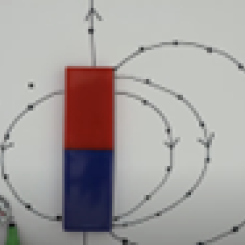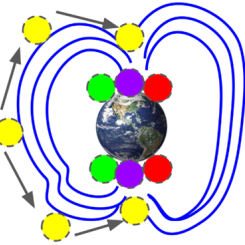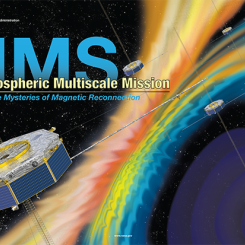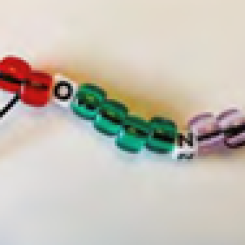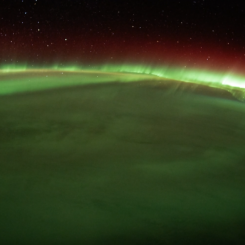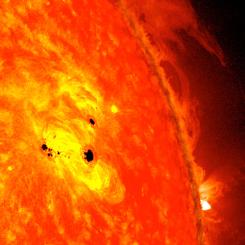Lesson Plans
Predicting Aurora
Overview
In this activity, learners predict the likelihood of aurora on Earth by examining the Kp-index and using NOAA’s 30-minute aurora forecast.
Emphasize to learners that what we observe about aurora can tell us about the activity on the Sun and help scientists monitor and predict space weather.
Materials Required
Procedure
Remember to never look directly at the Sun without proper safety equipment.
Observe:
Direct learners to examine images from NASA’s Aurora Image Gallery and ask them to record their observations, using the guiding questions:
- What colors do you observe in the light displays?
- What shapes do you observe in the light displays?
- At what time of day are the images taken?
Watch:
Direct students to consider the following questions as they watch the short video.
- What is the solar wind?
- What causes the solar wind to enter into Earth’s atmosphere?
- What happens when the solar wind bumps into particles in Earth’s atmosphere?
- Do other planets experience aurora? Which ones?
Context:
Aurora displays occur when the solar wind interacts with Earth’s atmosphere. The aurora is seen most often at the North and South Pole, and at high latitudes, because of the shape of Earth’s magnetic field, which originates from Earth’s poles.
Aurora are not always indicative of severe space weather, and can occur regularly at the poles, even with very little disturbance to Earth’s magnetic field. But during solar eruptions, like coronal mass ejections (CMEs), the disturbance in the magnetic field would cause the aurora to intensify and to be seen at lower latitudes.
Analyze Data:
- Direct learners to the Handout_Aurora Kp Map of North America.
- This map shows the Kp-index levels that are required to view aurora at different latitudes.
- When geomagnetic activity is low (Kp-3), the aurora typically can be seen in the hours around midnight, at about 67 degrees magnetic latitude (Alaska in the Northern Hemisphere). As activity increases, the region of aurora expands toward the equator.
- When geomagnetic activity is very high, caused by a CME, for example, the aurora may be seen at mid- and low-latitude locations around Earth that would otherwise rarely experience the phenomenon. Most of the continental U.S. is at mid-latitudes.
- A geomagnetic storm with a Kp-9 can be seen in Washington, DC, with the right kind of conditions.
- Other conditions that affect viewing the aurora include cloud cover, light interference from the full or near-full Moon, and light pollution from nearby cities.
- Direct learners to NOAA’s Space Weather Prediction Center 30-minute Aurora Forecast, which offers real-time data on current aurora conditions.
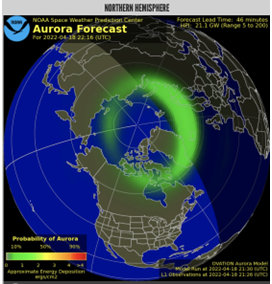
- Instruct learners to watch the forecast and answer these guiding questions in their analysis of the data:
- What is the probability of seeing an aurora at high latitudes (near the pole) right now?
- Is there any chance of seeing an aurora near where you live?
- What does this data tell you about the current activity on the Sun?
Give learners time to examine the forecast. Have learners share their observations.
Teachers who are interested in receiving the answer key, please complete the Teacher Key Request and Verification Form. We verify that requestors are teachers prior to sending access to the answer keys as we’ve had many students try to pass as teachers to gain access.
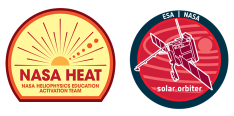
Disciplinary Core Ideas:
- PS2B: Types of Interactions
- PS4A: Wave Properties
- PS4B: Electromagnetic Radiation
- ESS1A: The Universe and its Stars
Crosscutting Concepts:
- Patterns
- Cause and Effect
- Structure and Function
Science and Engineering Practices:
- Developing and Using Models
- Students will be able to describe what causes aurora.
- Students will be able to predict the occurrence of aurora using real time data.
- Students will be able to identify how the Sun affects where aurora can be observed on Earth.
- Why are aurora commonly seen at Earth’s poles?
- What happens on the Sun that causes auroral displays to be seen at lower latitudes?
Students may think aurora only occur during solar storms.
NASA’s STEREO Mission is a mission designed to help us understand the Sun's influence on Earth and near-Earth space by studying the solar atmosphere in many wavelengths simultaneously. Using two nearly identical observatories, one ahead of Earth in its orbit and the other trailing behind has traced the flow of energy and matter from the Sun to Earth.
Another mission that studies the Sun is NASA'S Solar Dynamics Observatory (SDO), which can take measurements in multiple different wavelengths simultaneously.

